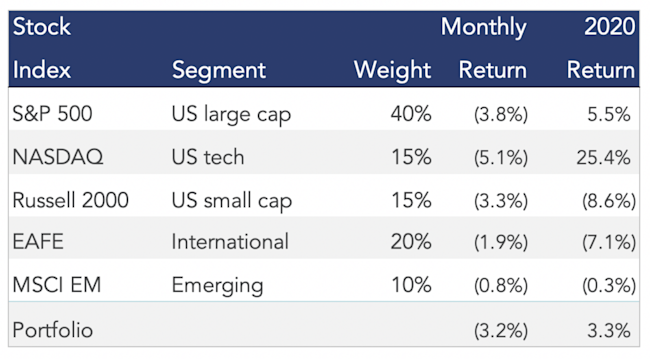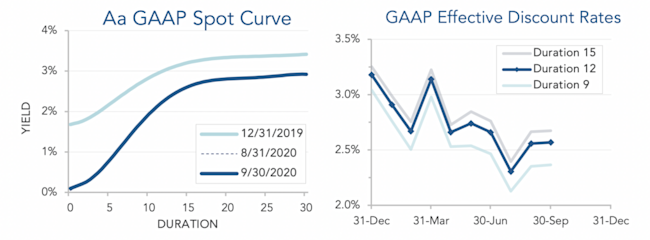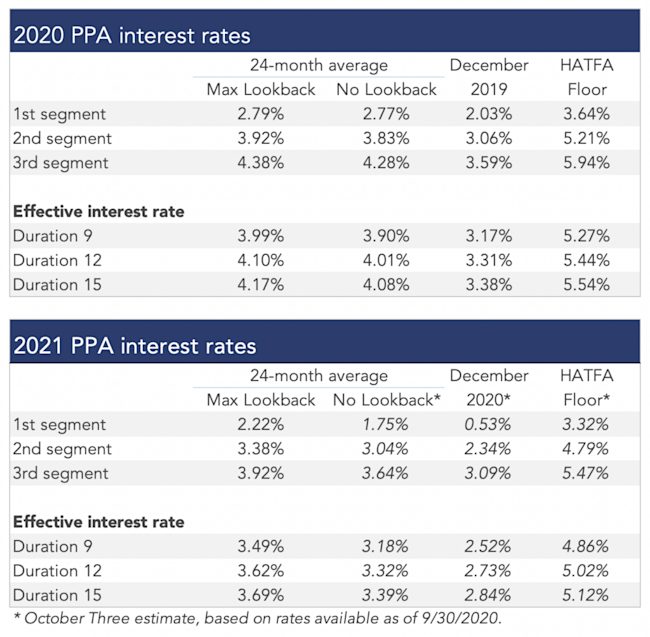
September 2020 Pension Finance Update
Lower stock prices hit pensions during September. Both model plans we track[1] lost ground last month, with Plan A dropping 2% and Plan B slipping 1% during the month. For the year, Plan A is now down 5% and Plan B is down more than 1% through the first three quarters of 2020:

Assets
Stocks, which rallied sharply since March, pulled back in September. A diversified stock portfolio lost more than 3% last month but remains up 3% for 2020, after being down more than 20% at the end of the first quarter.

Interest rates saw little change in September. As a result, a diversified bond portfolio was flat last month but remains up 10%-12% through the first three quarters of 2020, with long duration and Treasuries outperforming.
Overall, our traditional 60/40 portfolio lost 2% in September but remains up more than 5% for the year, while the conservative 20/80 lost 1% last month but remains up 8% through the first three quarters of 2020.
Liabilities
Pension liabilities (for funding, accounting, and de-risking purposes) are driven by market interest rates. The first graph below compares our Aa GAAP spot yield curve at December 31, 2019 and September 30, 2020, and it also shows the (tiny) increase in the curve last month. The second graph below shows our estimate of movements in effective GAAP discount rates for pension obligations of various duration during 2020:

Corporate bond yields didn’t move much in September, leaving pension liabilities flat for the month. Through the first three quarters of 2020, liabilities have increased 9%-13% for most plans, with long-duration plans seeing the largest increases.
Summary
Capital market volatility and credit spreads have normalized in recent months after a wild ride earlier this year. As the dust has settled, 2020 is looking like a negative year for pension sponsors due to all-time low interest rates pushing liabilities ever higher. The graphs below show the movement of assets and liabilities for our two model plans during the first three quarters of the year:

Looking Ahead
Pension funding relief has reduced required plan funding since 2012, but this relief will gradually sunset. Plans that have only made required contributions in the past can expect significant increases in required contributions over the next couple years under current law.
2020 experience, if it persists, will not increase required contributions until 2022, compounding higher funding requirements due to the fading of funding relief. There is some chance we get more relief this year, but at this point it’s too soon to say for certain.
Discount rates were largely unchanged last month. We expect most pension sponsors will use effective discount rates in the 2.3%-2.8% range to measure pension liabilities right now.
The table below summarizes rates that plan sponsors are required to use for IRS funding purposes for 2020, along with estimates for 2021. Pre-relief, both 24-month averages and December ‘spot’ rates, which are still required for some calculations, such as PBGC premiums, are also included.

[1] Plan A is a traditional plan (duration 12 at 5.5%) with a 60/40 asset allocation, while Plan B is a largely retired plan (duration 9 at 5.5%) with a 20/80 allocation with a greater emphasis on corporate and long-duration bonds. We assume overhead expenses of 1% of plan assets per year, and we assume the plans are 100% funded at the beginning of the year and ignore benefit accruals, contributions, and benefit payments in order to isolate the financial performance of plan assets versus liabilities.
